Sea Sandwort – Identification, Edibility, Distribution, Ecology, Sustainable Harvesting, Recipes
Honckenya peploides
Aka sea chickweed, sea pimpernel, sea-beach sandwort, lus a’ghoill – “Stranger’s plant” in Scots Gaelic, seaside sandplant (Canada) and sea purslane (though in the UK sea purslane generally refers to a different edible coastal plant – Atriplex portulacoides).
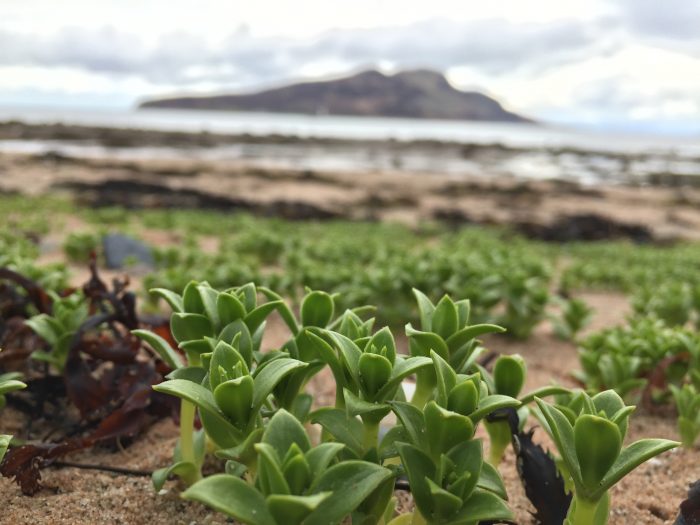
Sea sandwort. ©GallowayWildFoods.com
Edibility – 4/5
Sea sandwort is a delicious succulent perennial plant with good texture and a flavour reminiscent of cucumber skin and pea shoots. The whole of the above-ground plant is edible, though their excellent flavour in early spring becomes bitter when they start to flower, which is usually around mid May in SW Scotland. Foraging friends in S England report that new, mild tasting growth starts to appear again in the autumn, but in Scotland’s shorter growing season you only get one chance between mid March and May.
The shoots can be eaten raw, as a seaside nibble or in salads, or cooked by steaming or stir-frying and eaten as a vegetable. See my notes on Cooking with Sea Sandwort below.
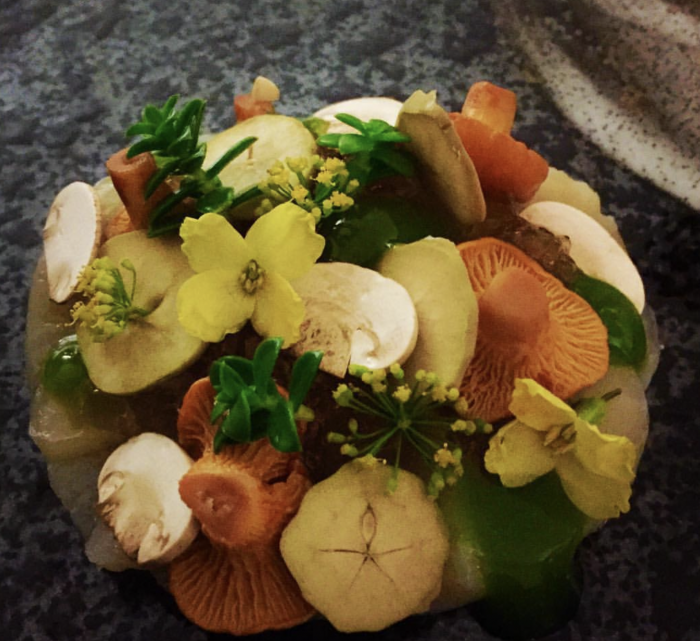
Sea sandwort makes a beautiful and tasty garnish. Served here with early chanterelles and May flowers, by my friend Craig Grozier.
Its a true gift of nature, and easy to find and identify. We even harvest this this in exposed and heavily deer and sheep grazed locations on sea kayak expeditions up Scotland’s West coast, when many other coastal succulents aren’t available. I don’t think its that the deer or sheep don’t like it, but that its unpromising location tends to keep it off their radar.
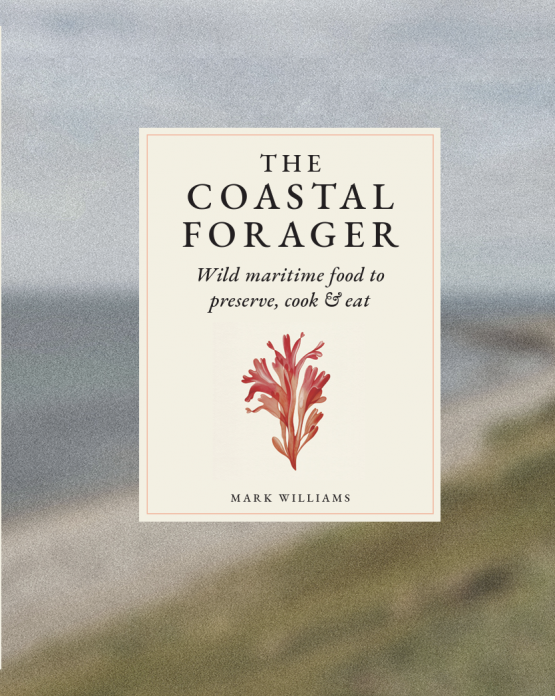
For more information and recipes on sea sandwort, see my book – The Coastal Forager.
Given its name, and home, it isn’t surprising that sea sandwort requires a lot of rinsing to divest it of sand! It only takes one grain of sand to turn a pleasurable eating experience grim, so do it justice by rinsing thoroughly in several changes of water.
Sea sandwort is rich in vitamins A and C.
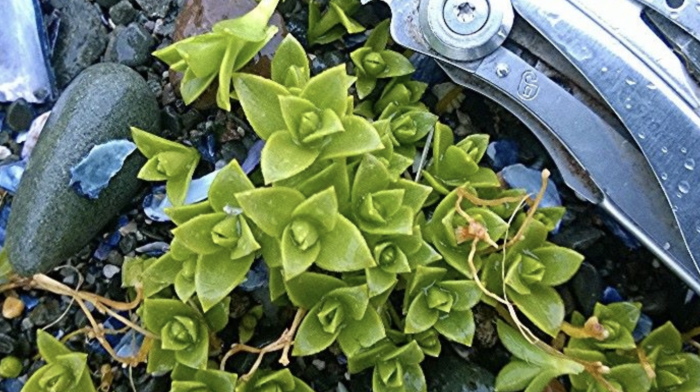
Sea sandwort, early April, Galloway. ©GallowayWildFoods.com
Identification – 5/5
Sea sandwort is hard to mistake in its coastal habitat, and has no troublesome look-alikes. It forms dense mats of small succulent shoots with triangular to oval shaped leaves growing in symmetrical pairs up the stem. Each pair of leaves sits at right angles to the previous pair, so viewed from above their 4-way symmetry is striking and beautiful. Stems branch below ground (sand) level, so usually all you see are what seems to be lots of individual shoots. The above ground section, which is bright green, becoming more yellowy as it matures and declines, usually grows to about 3cm – 8cm tall, depending on its exposure to the wind. If the sand is disturbed you will see the longer, below-ground part, which is pale yellow to whiteish, forming dense mats, which persist through the winter.
Tiny white five petalled flowers start to appear around mid May in SW Scotland, and this is the time when its mild tasting foliage starts to develop an unpleasant bitterness.
Once pollinated (see below for their interesting sexuality!), they develop seed capsules that resemble small peas. They are designed to float away in the sea to colonise new locations.

Sea sandwort in flower, late May, Galloway. At this stage the leaves become bitter.
Habitat
Coastal sand and shingle beaches, just above the mean high tide line. Sea sandwort is a miracle of resilience and ingenuity, being able to withstand fairly regular immersion by the sea, coastal exposure, free draining sand and the ever-changing nature of its coastal home.
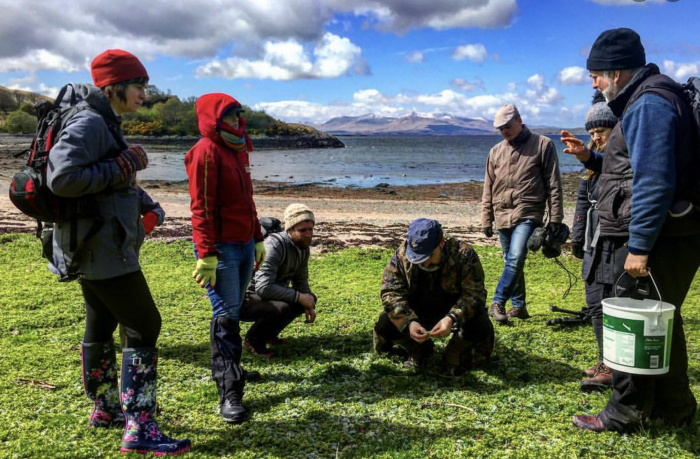
Exploring sea sandwort just above the high tide line. The whole green carpet beneath our feet is sea sandwort. ©GallowayWildFoods.com
Distribution
Sea sandwort is common and often abundant in suitable habitats all around the UK and much of northern Europe and N America. In some locations it can form a strip several metres wide for many miles.
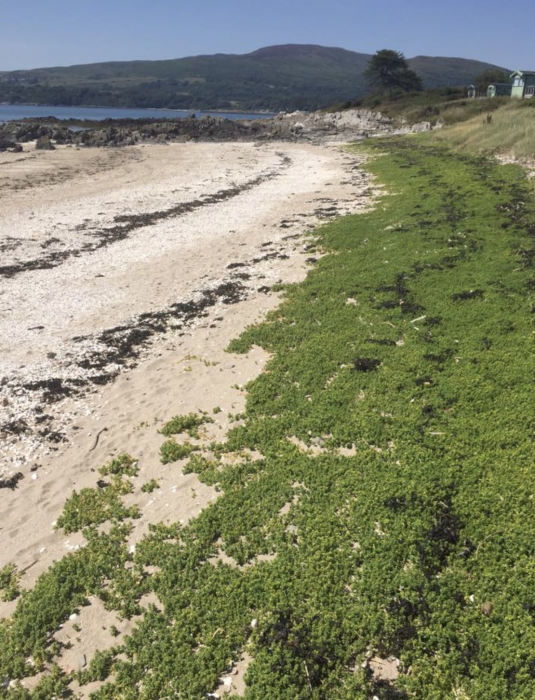
The whole of the green strip you see in this image is sea sandwort. ©GallowayWildFoods.com
Ecology
Sea sandwort plays an important role in stabilising sand and shingle, allowing other plants such as sea radish, sea beet, sea kale and sea campion to colonise the foreshore.
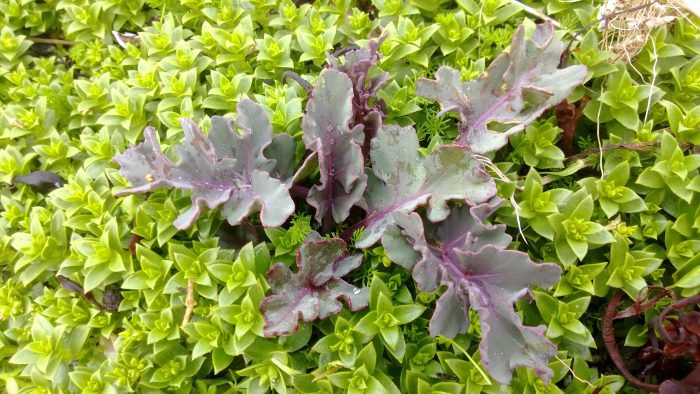
Sea kale growing through sea sandwort, Galloway, April. The stabilising actions of sea sandwort allows other plants to colonise coastal habitats. ©GallowayWIldFoods.com
It provides shelter for sand hoppers (Talitrus saltator) and other crustaceans of the upper shore, that sea birds like to feed on.
It is a sexually ambiguous, having both male, female and hermaphrodite growth habits. Some colonies will display males flowers with stamens and female flowers with smaller flowers bearing long styles and (later) seed capsules. But others have been found with individuals displaying male flowers and later, seed capsules, on the same plant. It seems that sea sandwort as a species may be transitioning to hermaphroditism, a reproductive strategy that may be better suited to challenging, resource-poor habitats. I think its pronouns are they/them. 😉
Flowers are visited by small bees, hover-flies, flies and ants.
The thick, fleshy, waxy leaves of sea sandwort have evolved to help it retain fresh water and resist salt as well as making it resistant to the abrasive action of wind and tide driven sand and shingle. This also helps it stand up quite well to trampling – quite fortunate as it often grows along popular bathing beaches and beauty spots.
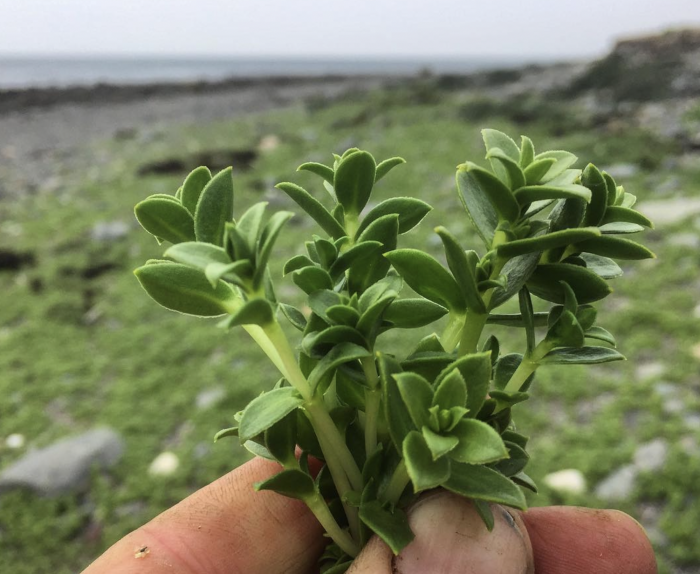
Sea sandwort, mid April, Galloway. The whole shoot is edible. ©GallowayWildFoods.com
Sustainable Harvesting
Being extremely abundant, widely dispersed, resilient and fairly fiddly to pick, you’d have to be recklessly ignorant to threaten this remarkable little plant through foraging. However, its very abundance helps to maintain coastal habitats, so please treat it with the respect you would any other hard-working eco-engineer!
Don’t pull it up. The below ground bits – part shoot, part root (its hard to tell where one ends and the other begins) are stringy, difficult to clean, gastronomically unrewarding, and you’ll be undermining future growth of this perennial plant.
Thin abundance rather than clear felling whole areas. I think it is acceptable to hold tufts of shoots and cut them carefully from below with a sharp knife, provided you don’t repeat that process over and over in the same location. There is always another patch of sea sandwort nearby, so spread your picking around. Try to harvest from the middle rather than the edge of colonies.
The area around the high tide line is a plastic waste catastrophe zone, so sadly there is ample opportunity to give something back by taking away a lot more plastic than sea sandwort.
While it is quite resilient to trampling, it does seem like bad manners to tread on something that is about to feed you!
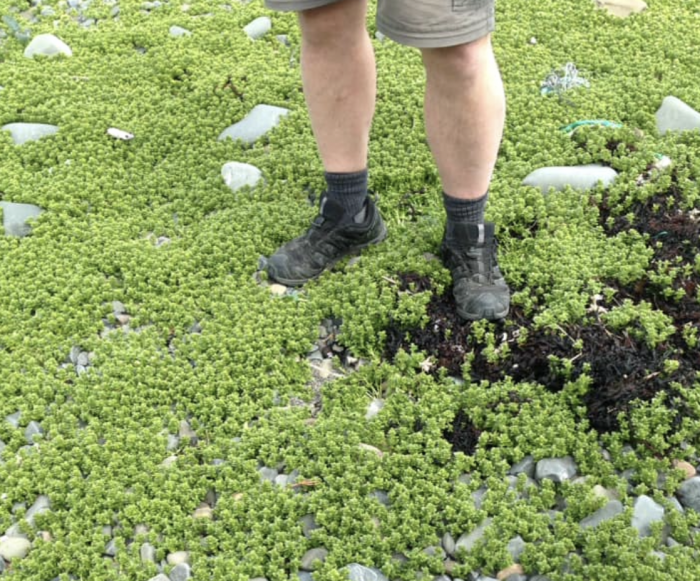
Sea sandwort is hardy and resist moderate amounts of trampling, but would probably rather you didn’t!
Cooking with Sea Sandwort
Being mild tasting (at least before it flowers) and succulent, sea sandwort is perfect for eating raw in salads, or scattered on dishes at the last minute to add a bit of fresh crunch. Raw, or perhaps very lightly steamed, its great for dipping in hollandaise or wild garlic mayo.

Steamed sea sandwort and sea kale, with hollandaise for dipping
It isn’t an aromatic plant – its flavour is locked deep in its flesh, and not dispersed by volatile compounds, so I see it as an “eater” not an “infuser”. However, its stunning good looks, ability to float, and cucumber flavour profile make it irresistible as a garnish for cocktails – especially gin-based ones. My friend and wild booze-meister Ally Kelsey makes a phenomenal cocktail by juicing sea sandwort and blending it with gin, sorrel and floral infusions. It comes out a stunning green!
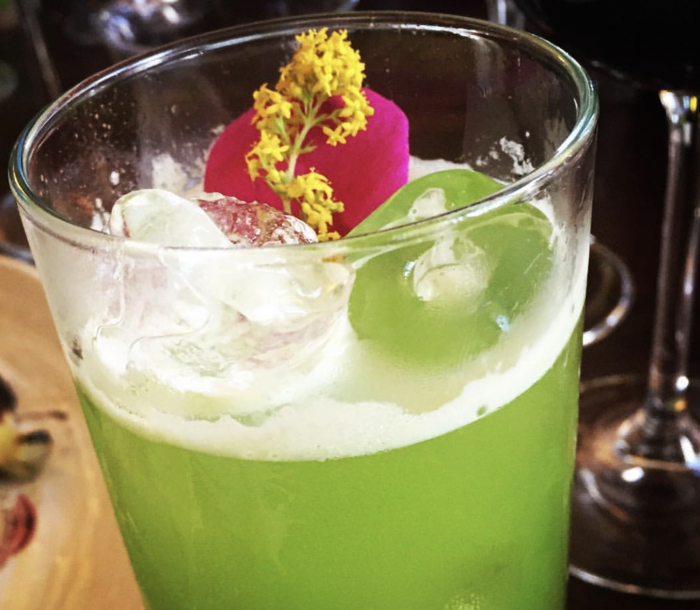
“Sea Salad” cocktail, by Ally Kelsey.
To a certain extent, the bitterness that sea sandwort develops on flowering can be tempered by blanching before use, but for me its always there in the background, so I prefer to keep them as a spring treat, or live off harvests preserved in the spring. Like many other succulent coastal plants, their juicy inner and waxy skin makes them ideal for pickling and they also ferment well – see my post on How to Ferment Wild Greens for how to do this.
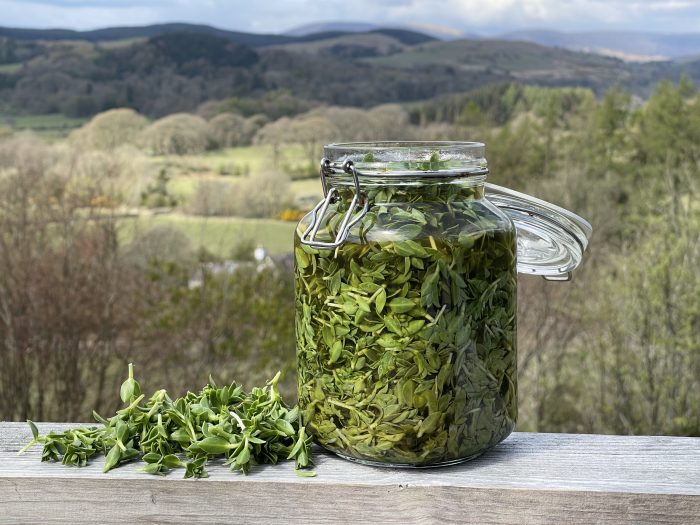
Sweet pickled sea sandwort.
©GallowayWildFoods.com
Its succulence also lends sea sandwort to pickling as the leaves don’t break down in the acidic pickling solution like less fleshy inland greens. There is no need to heat or cook sea sandwort when pickling – simply wash thoroughly, place in a jar and pour over a cold pickling mix – I recommend starting with the magic pickling proportions of a 3 : 2 : 1 mix – that is 3 parts water, 2 parts apple cider vinegar and 1 part sugar, plus a generous pinch of salt – then tweaking to your preference. Adding sea lettuce raises the pickle to new (coastal) heights, with its complimentary umami-cucumber flavours.
For a more detailed rundown of the pickling process, including some nice wild herbs you can add to mix, see this recipe (there is no need to pre-salt sea sandwort as I do with the wild garlic buds).
For a deep dive into hot-pickling of wild mushrooms (which also works for other wild harvests) see here.
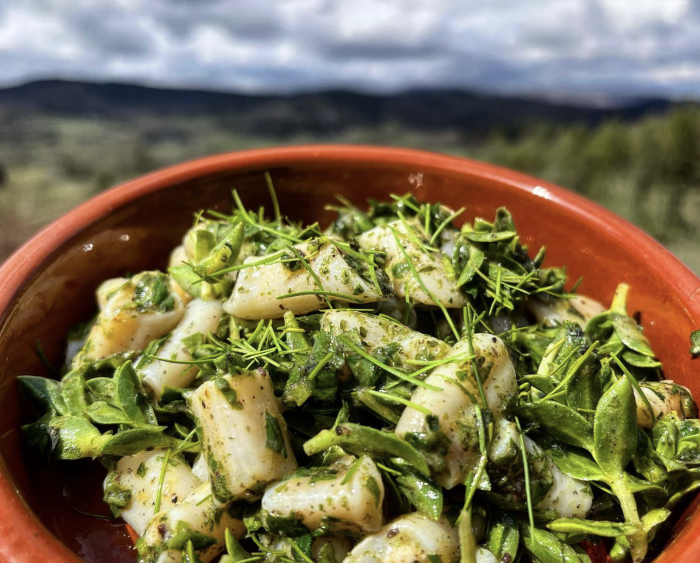
Ceviche of spoot/razor clams, with sea sandwort, larch tips, sorrel, ground elder, sea lettuce, pepper dulse & barley miso.
©GallowayWildFoods.com
Related Posts:
- Edible Coastal Plants
- Sea kale – Identification, Distribution, Edibility, Ecology, Sustainable Harvesting
- Sea radish – Identification, Distribution, Edibility, Ecology, Sustainable Harvesting
- Sea Campion – Identification, Distribution, Edibility, Ecology, Sustainable Harvesting
- Sea beet – Identification, Distribution, Edibility, Ecology, Sustainable Harvesting
5 Comments
Toxic for dogs?
Not that I know of. I’m no vet though. But i’d be surprised if it was.
This was fantastic reading. I’m from Portugal, hope this information applies to the sea sandwort we have here. Thanks for so much good info! X
Good afternoon I discovered some wild Sea Sand Wort growing wild in South Africa. I am fascinated by the plant. I cannot find a lot of information regards the nutritional value of Sea Sand Wort plant. I am a well Controlled Insulin dependent diabetict since 1957. Please could you let me know the carbohydrate contents of perhaps 100 grams of Sea Sand Wort. I have thought it should be very similar for example to spinage.. I have boiled some spinage and did not find any dramatic difference between the two plants. I look forward to your response.
Kind regards
Len Maasburg
Len Maasburg
HiLen, sorry, I have no idea what the carb content would be. Chemical analysis is costly and wild plants don’t have wealthy businesses promoting them!